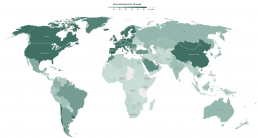By Steve Kerge and Meryl McDonough
As a higher education professional, you already know the facts when it comes to international student recruitment. In short, it’s been a tough few years. The COVID-19 pandemic halted international travel, which affected both in-person recruitment as well as admitted students’ ability to enter the United States to attend their dream schools.
According to the latest annual Open Doors survey, the 2019–2020 academic year saw a 43% decrease in new international student enrollment in the United States, which contributed to a 1.8% decline in total international enrollments from the previous year—the first decline recorded since the 2005–2006 academic year.

What may surprise you is that many of the major factors impacting international student recruitment are not new. While the COVID-19 pandemic accelerated the decline in the international market, several other factors have been fueling the fire for almost a decade.
- Most widely known, the increased political and social unrest within the United States has painted us in a negative light for many students looking to pursue a degree here. This has also led to increased confusion around the rules and regulations within the United States, muddying the decisions for those considering to study here.
- Many foreign countries have long provided their students’ government-funded scholarships through national scholarship programs. Recently, many countries, such as Brazil (through their Brazil Scientific Mobility Program) and Saudi Arabia, have defunded these scholarship programs, making an education in the United States largely unaffordable.
- Over the past several years, the value of the U.S. dollar has increased substantially, again making it harder for international students to afford a non-funded education in the United States.
- Large pathway programs are beginning to emerge, making it harder for many U.S. schools to compete in this arena. These programs create partnerships with select universities in the United States and encourage International Student Recruitment Agents to send their students to the finite set of U.S. schools with which they have agreements.
- The competition within the international market has grown substantially and students are finding they have more options on where to pursue their degrees. Many countries, such as China, India, and Germany, which were once large exporters of students, are beginning to retain more of their own citizens. Additionally, countries such as Australia, Canada, and even the United Kingdom are enhancing their long-term visiting student options and making it easier for students to obtain a visa, placing additional strain on the international market for the United States.
- Finally, rankings continue to have a heavy influence on the international market, leaving a heavier burden on the smaller, more regional institutions.
At first, it’s easy to be bearish on the short-term future of international student activity when you consider the points above. However, we believe there’s an international renaissance on the horizon. Allow us to point out a few important facts that may help sway your opinion:
COVID Deferments Offer Great Potential
According to an iie research study published in November of 2020 40,000 students deferred their enrollment from Fall 2020 to a future semester.

When you factor in a combination of these deferments with the traditional new-student application activity we’ve already seen for Fall 2021, as well as what you can expect for Spring 2022 and Fall 2022, signs of growth begin to show.
COVID Vaccinations Are On The Rise

Source: The New York Times
U.S. colleges can begin to work with the U.S. government and those in other countries to offer vaccinations for incoming international students who otherwise might not be able to get vaccinated in their home countries or even in other competing countries.
The idea that an incoming student can test negative prior to coming here, test again upon arrival, and then get vaccinated can prove to be both career and life changing.
The U.S. Is Regaining Its Global Image As A Friendly Place
Based on recent reports, many U.S. admissions officers are feeling more optimistic about their ability to attract students from abroad, now that the new Biden administration is setting a more welcoming tone for international students than we’ve seen in the last several years. For example, in one recent article, Xiaofeng Wan, Associate Dean of Admission and Coordinator of International Recruitment at Amherst College in Massachusetts, told Inside Higher Ed that he believed families are beginning to feel more comfortable sending their children to the U.S. again. Also, according to Forbes, a recent poll by Morning Consult found that global opinion of the U.S. in general has improved quite significantly in the months since President Biden took office.
Positive Domestic Enrollment Trends
Historically, domestic enrollment trends have always been a strong indicator of where the international recruitment market is headed—though you can expect roughly a year of lag time. As vaccinations take effect and further empower U.S. institutions to return to fully in-person and on-campus environments, Spark451 strategists are hearing overwhelmingly optimistic outlooks on domestic enrollment for Fall 2021 from enrollment managers across the country—at institutions of all sizes and types.
"Over the last 14 months, Fisher College turned crisis into opportunity. Through virtual recruitment and a strong CRM (Element451), the College diversified its recruitment strategies to attract a strong applicant pool. These new strategies are paying dividends in the form of increased new student yield for the Fall 2021 semester and elevated student engagement for Fall 2022 and beyond!"
Robert Melaragni, Vice President of Enrollment Management at Fisher College
By and large, enrollment managers are satisfied with their Fall 2021 classes, and considering where they were just 12 months ago, they are bullish on the future for their schools as they re-engage domestic recruitment plans for Fall 2022.
Looking Ahead With Optimism
In spite of some recent interruptions in the market, international students remain a critical component of the ecosystem at most U.S. colleges and universities, and we expect that to continue well into the future. As the pandemic continues to recede and our nation’s political leaders continue to reestablish a more welcoming tone for foreign students, the Spark451 enrollment strategy team can’t help but feel especially hopeful about all of the new and emerging opportunities in this arena. In fact, we’re already hearing positive rumblings from the institutional leaders from across the nation with whom we speak daily.
“The international students we receive from more than 30 countries around the world add tremendously to the culture, diversity, and learning experiences of our entire campus community. Despite the challenges faced by so many during the pandemic, we have not stopped supporting our current international students and our global partners overseas in every way possible. Even though our numbers of international students from overseas declined last year, we did receive new international students who were already in the United States, and our numbers of new students are looking promising once again for Fall 2021. International strategic enrollment management does not happen by accident. It takes the right motives, people, a commitment to positively impacting the lives of our students and lots of hard work. Because of our shared values, we feel Western New England University is in a strong position to continue to educate a diverse group of international students for many years to come.”
Bryan Gross, Vice President for Enrollment Management and Marketing at Western New England University
Let's Connect
We look forward to helping your institution connect with talented students from around the globe in coming cycles! Reach out when you’re ready to discuss specific strategies and tactics to help you reach your international student recruitment goals.
